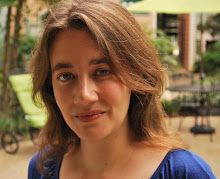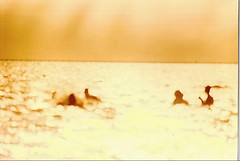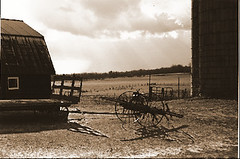Low Key Lighting in a Billy Wilder Noir
The opening sequence of Double Indemnity sets the tone and the pacing of the entire film. In roughly ten shots, a car careens in the middle of the night and runs a stop light before finally parking in front of a locked, dark office building. Within moments, the audience can see that the man in the car is a trusted employee of an insurance firm, that he has been shot, and that he is spending what might be his final moments recording a confession via Dictaphone for his boss and role model to discover after he’s gone.
By the second scene, the audience has been informed of all that has happened; what’s left to ascertain is how it happened. The insurance salesman’s Achilles heel and foreshadowing for the film make themselves known in that next, vital scene. Symmetrical cinematography provides a solid basis to grasp how it is that the hero is taken in and left for dead, but the camerawork also uses gentle subterfuge in the meeting scene between Walter Neff and Phyllis Dietrichson that creates a lopsided sense of space and a power balance between its main characters. Since the plot’s mainstay composition is the power struggle between these two, studying this scene lends insight and even some stability to what is a very steamy and turbulent romance-murder. It is the events of the second scene upon which the protagonist can ruminate and conclude that that’s the point at which he should have walked away; so, it is no mistake that a dying man begins his story here.
The first shot of the second sequence establishes the expensive house set on a nice vista where a simple pan reveals children playing ball in the driveway and an ice cream truck taking a leisurely drive through the neighborhood. The sense of movement in this first shot establishes the flow as the ice cream truck proceeds off screen in the opposite, angled direction that Walter Neff goes as the camera tilts and he ascends the elegant stairs. The camera then renders a medium shot of Neff as the housekeeper answers the door. Their conversation is shot almost completely as an exterior shot, but Mrs. Dietrichson, whose husband’s insurance coverage is up for renewal, appears in nothing but a bath towel on a railed landing at the top of the stairs. The frame quickly cuts from an interior medium shot of Neff with the housekeeper to the lady of the house up above them.
The low angle of the shot at first reveals nothing more spectacular than Phyllis Dietrichson’s scantily-clad appearance, but the return shot on Neff as he takes off his hat is a high angle shot, somewhat closer. It is in this interplay that the first power struggle takes place, but it won’t be the last. Mrs. Dietrichson ventures closer to the railing in the next cut back to her, unafraid to let him see her even as the housekeeper watches. Though prescribed societal roles would suggest that the woman should feel more vulnerable in a situation such as this, it is the insurance salesman who is disarmed in a second high angle shot, perhaps even fooled by a return to the low angle in which Phyllis moves slightly right within the frame, somewhat obscured by a rug hanging over the railing. Upon the third high angle framing of Neff, he continues the tease in a remark about pigeons, but in the last low angle shot of Phyllis, the angle is much steeper. Her seeming timidity is now understood to be just part of the flirtation; she still seems to hold the upper hand.
At the very least, she clearly asserts her position.
To regain symmetry after this power play, the camera returns to the medium shot that normally would have followed Neff’s entrance more substantially. This time, though, the lighting has brighter notes, as if the two had stepped into the light and Neff had all but revealed himself. The camera pans to the living room as Neff walks toward it and then cuts to an establishing shot in which only the entrance of the living room and the mirror can be seen in the foreground, while the staircase from which Phyllis must eventually descend comprises the ominous background. All of the shots thus far have been angled in such a way to keep movement in a uniform position, and the shot of the staircase follows suit; i.e., the direction of the stairs inside the house matches those without the house.
To lend the living room a sense of 360 degree space, the camera then follows Neff around the room in a carefully constructed manner. He walks to the piano in a pan shot, the camera cuts to an over-the-shoulder close-up of pictures of Lola and Mr. Dietrichson, and the audience is greeted with a second establishing shot of the greater part of the living room, in which the two will spend most of their time together in just a few minutes. At the tail end of this series of shots, there’s a slight pan to follow Neff’s movement, but the camera stops and he walks into a spot of light. The next cut reveals a close-up tracking shot of Mrs. Dietrichson’s feet descending the inevitable steps. A quick zoom-out at the bottom of the steps reveals that she’s just now finishing up with buttoning her blouse, and the shot continues tracking until she goes to the mirror to admire herself and exits the shot. Neff follows her out of it, too, as the camera remains more or less on the mirror.
This sort of stop-gap sense of motion continues. Just as Neff paced around the room in a circular manner, now Phyllis will pace, too, as part of her coquettishness. But special attention should be paid to symmetry, also. First, the characters sit down into a still medium shot, she in a chair somewhat lower than him and he on the arm of the couch. Thus the second power play begins. He notices her anklet, and she uncrosses her legs. The camera tilts and pans as Phyllis gets up from the chair and it pans back and forth as she paces. When she pauses to ask Neff two questions, a brief cut reveals a medium shot of Neff still sitting on the arm of the couch, now somewhat lower than her. The camera returns to Phyllis, panning again as she resumes her seat within the same frame the pair originally sat. She re-crosses her legs and Neff’s attention is once more seized by the anklet, made clear by a close-up on his face. It’s also the cue for the third power struggle in the scene.
The camera tilts, pans and slightly zooms in on the two as they stand and move clear of the couch. It’s as close together as they get in this scene while facing each other. A close-up on Phyllis as she tells Neff that there’s “a speed limit in this town” is quickly followed by a close-up on him telling her to give him a ticket. The next and last close-up Phyllis mentions her husband and the flirtation swiftly ends. Or so it seems.
In the final shot of the scene, the camera’s medium tracking shot on Neff traces their path into the living room in the first place. First, it moves to the mirror where he reclaims his hat and then to the door, where the two have one final exchange of words. It is clear from the way the scene ends that whatever happened between these characters has not ended, but rather just begun.
The most tangible words of the opening sequence is probably the bit about how Neff “didn’t get the money, and [he] didn’t get the woman.” There’s an ambling sense to this scene, in the way that the motion is constructed, that sets off the inevitability of the entire affair – romance and murder, to boot. It’s as though just in the course of daily motion (a prerequisite in the insurance business) that a person can never foresee very well in what direction his life might go at any moment, not even an insurance salesman.
Labels: Bordwell and Thompson Series, Film, Noir
















2 Comments:
Amsterdam at night is absolutely wonderful. I love the fact that the city and its denizens put out so many little lights. It makes the city seem magical regardless what the weather's like.
escort sydneyVIP London escorts
Tân Hoàng Minh Quảng An
Chung cư Tân Hoàng Minh Quảng An
Dự án Tân Hoàng Minh Quảng An
D’.Le Roi Soleil
chung cư quảng an tây hồ
Chung cư D'.Le Roi Soleil
Post a Comment
<< Home